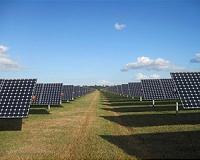 |
Houston TX (SPX) May 04, 2011 Rice University senior engineering students are using the sun to power an autoclave that sterilizes medical instruments and help solve a long-standing health issue for developing countries. The student's used Capteur Soleil, a device created decades ago by French inventor Jean Boubour to capture the energy of the sun in places where electricity - or fuel of any kind - is hard to get. In attaching an insulated box containing the autoclave, the students transform the device into a potential lifesaver. The Capteur Soleil, which sits outside Rice's Oshman Engineering Design Kitchen, looks something like an ultramodern lawn swing. Its spine is a steel A-frame, and a bed of curved mirrors beneath the frame produces steam by focusing sunlight along a steel tube at the frame's apex. Rather than pump steam directly into the autoclave, the Rice team's big idea was to use the steam to heat a custom-designed conductive hotplate. "It basically becomes a stovetop, and you can heat anything you need to," said Sam Major, a member of the team with seniors Daniel Rist, David Luker and William Dunk, all mechanical engineering students. "As long as the autoclave reaches 121 Celsius for 30 minutes (the standard set by the Centers for Disease Control and Prevention), everything should be sterile, and we've found we're able to do that pretty easily." He said one person could easily adjust the Capteur Soleil by ratcheting up the back leg to align the mirrors with the sun. Within half an hour of receiving strong sunlight, the Capteur Soleil will begin to produce steam, which will in turn heat the patterned hotplate and then the standard-issue, FDA-approved autoclave. With good midday sun, Major said, it takes 40 minutes to an hour to begin significant heating of the autoclave. The autoclave, which looks like a tricked-out pressure cooker, has a steamer basket inside. "We put about an inch of water inside, followed by the basket with the tools and syringes," Major said. "We've used some biological spores from a test kit, steamed them, and then incubated them for 24 hours and they came back negative for biological growth. That means we killed whatever was in there." The autoclave, tucked inside a plywood frame, is wrapped in silicon-based Thermablok insulation, which has the highest R-value of any known material and is a spinoff from NASA research into thermal protection for the space shuttle. "This thin layer does most of the work," Major said. "We used standard pink insulation around the inside just to make the box stronger." "This is really the latest iteration of a much larger project," said Doug Schuler, the team's faculty adviser and an associate professor of business and public policy at Rice's Jones Graduate School of Business. "We already have a version of the Capteur Soleil being used in Haiti for cooking, but we felt it could do more."
Share This Article With Planet Earth
Related Links Rice University All About Solar Energy at SolarDaily.com
 NJR Clean Energy Ventures Announces Solar Project
NJR Clean Energy Ventures Announces Solar ProjectWall NJ (SPX) May 04, 2011 NJR Clean Energy Ventures (NJRCEV) has announced an agreement with the Village at Manalapan Solar to lease 13 acres of land in Manalapan, New Jersey, for a state-of-the-art, ground-mounted solar system. The 3.6 megawatt, $18 million, project will be capable of generating enough electricity to power 450 homes annually. Once installed, the power generated by the system will be used to serve the wh ... read more |
|
| The content herein, unless otherwise known to be public domain, are Copyright 1995-2010 - SpaceDaily. AFP and UPI Wire Stories are copyright Agence France-Presse and United Press International. ESA Portal Reports are copyright European Space Agency. All NASA sourced material is public domain. Additional copyrights may apply in whole or part to other bona fide parties. Advertising does not imply endorsement,agreement or approval of any opinions, statements or information provided by SpaceDaily on any Web page published or hosted by SpaceDaily. Privacy Statement |